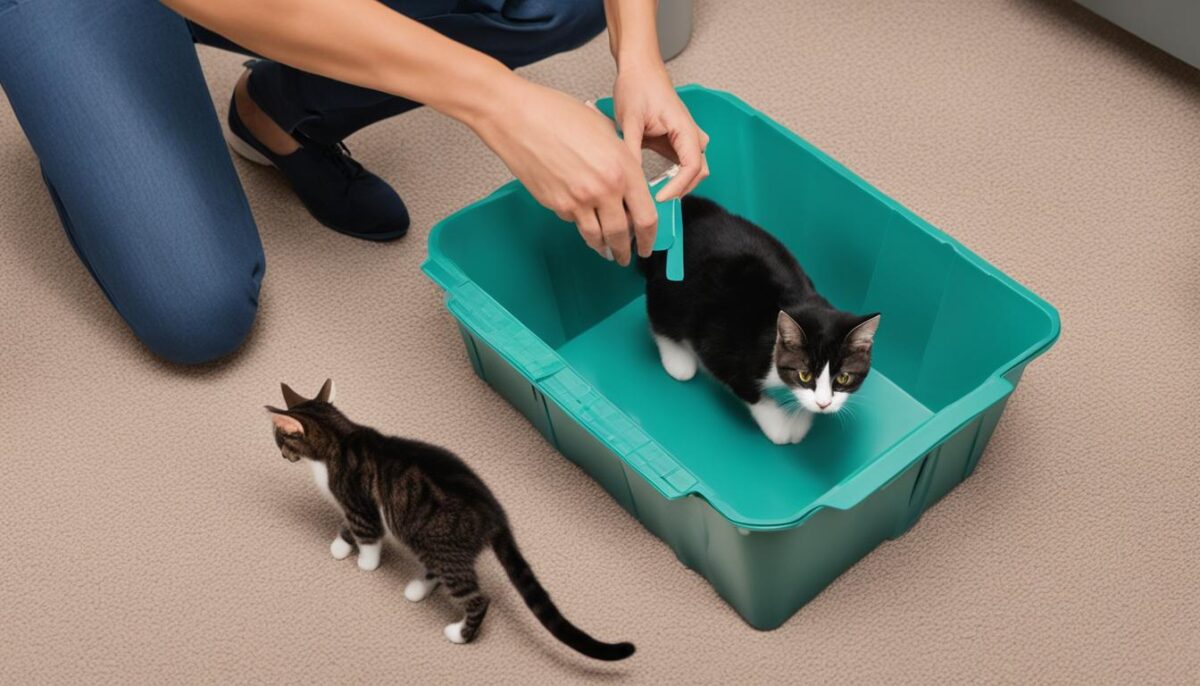Welcome! Have you saved a stray cat and brought it indoors? If you have, you’re doing a great thing. Now, you might wonder how to help your new cat learn to live indoors. Don’t worry, learning to house train your stray cat can be easy. It’s about helping them feel safe and teaching them where to go when they need to use the bathroom.
To start, know that stray cats can learn to become indoor cats. They can get used to a litter box, just like they used to go outside. But, they need your help to learn this new way.
Think about where the cat came from. Were they used to people, or did they live on their own without much human touch? Each cat is different. So, you must choose the right litter and box. You also need to decide on the best place in your home for it.
Don’t worry. With a little time and love, your furry friend will learn to trust you. They’ll be happy and comfy living inside with you in no time.
Key Takeaways
- Help your stray cat become an indoor cat with ease.
- Pick the right litter box and put it in a good spot.
- Teach your cat to trust you and feel cozy inside.
- Use a litter box to keep your home clean and neat.
- Stay calm and be patient with your new furry pal.
Understanding Your Newly Adopted Stray Cat
Welcome to the world of stray cat spectrum! When you bring a new feline friend home, figuring out where they fit on this spectrum is your first step. Some cats are what we call socialized. They like people and are pretty chill about hanging out with us. Then, there are semi-feral cats. They’re a bit more cautious and might not want to be touched, but they’re still kind of curious about us. And totally feral cats? They’re pretty much wild and not used to people at all.
Identifying Your Stray: Socialized, Semi-Feral, or Feral
Getting to know if your stray cat is socialized, semi-feral, or feral is super important. Socialized cats will be cool with you from the get-go. They don’t mind a good petting session and will hang around you a lot. This makes things like semi-feral cat taming a whole different ball game. These kitties are the in-betweeners – not exactly lap cats, but they might toss a glance your way or chat with a meow. They need more time to warm up to the idea of being a full-time human companion.
Establishing Trust with a Semi-Feral Stray
Here’s where patience becomes your best friend. Semi-feral kitties need space. Like, a lot of it. They won’t usually come up for a cuddle, but don’t feel sad. It just means you’ve got a bit more work to do in building trust with strays. Let your new kitty come to you. When they start feeling comfy, that’s when you know you’re making progress!
The Importance of a Calm Approach
A calm you equals a calm kitty. Semi-feral cats, especially, can be super sensitive to our vibes. They’re pretty good at picking up on how you feel. So, when you’re around them, keep it chill. No big movements or loud noises. This cool, calm approach is super key to making your new furry pal feel safe. With time, they’ll see you’re a friend and start coming around more.
Remember, whether you’ve got a bold, social butterfly or a shy, semi-feral cutie, taking it slow and steady is the way to go. It’ll make all the difference in your journey together!
Preparing the Perfect Litter Box Set-Up
Getting a new cat means you have to think about where they will go to the bathroom. The litter box is important, and you want to make it just right so your cat will be happy to use it. Here’s how to pick out the ideal litter box and the kind of litter that smells good to cats with sensitive noses.
Why the Size and Type of Litter Box Matters
If the litter box is too small, your cat might not like using it. You need one big enough for your cat to turn around in, without touching the sides. A good rule is to get a box as long as your cat plus their tail, and as wide as your cat without their tail. Also, you don’t want a lid on the box. Cats like open boxes better because they can see around and feel safe.
The Best Litters for Sensitive Noses
Cats have strong noses and scents can bother them. This is why sensitive nose-friendly litter is best. It shouldn’t have any perfume smells. Silica crystal litter is a really good choice. It doesn’t make much dust and feels soft. Your cat’s paws will be happy too! The litter should be about two or three inches deep so that it feels just right for your cat to dig in.
| Litter Box Type | Pros | Cons |
|---|---|---|
| Open Litter Box | Easy for cats to enter and exit, good visibility for safety | Can spread litter if not careful |
| Covered Litter Box | Keeps smells in, less litter on the floor | May feel too closed for some cats |
| Silica Crystal Litter | Fewer smells, soft on paws, low dust | Can be more expensive than other types |
| Clay Litter | Often cheaper, easy to find in stores | Can be dusty and not as soft |
Choosing the Ideal Litter Box Location
Finding the right spot for a litter box is super important. You want your kitty to be happy and comfortable. Keep in mind that cats don’t like their food near their bathroom, so don’t put the litter box too close to where they eat and drink. If your cat used to live outside, you might want to start by placing the litter box outdoors where they are used to going, and then slowly bring it inside. If your cat lived in a shelter, pick a spot indoors that is easy to get to and where they won’t feel stuck. Remember, moving the litter box closer to your home should be a slow and patient process.
Here’s a handy table to help you understand where to place the litter box:
| Location | Pros | Cons | Best For |
|---|---|---|---|
| Outdoors | Familiar for outdoor cats, easy to clean up | Affected by weather, less secure | Cats transitioning from outdoors |
| Laundry Room | Out of the way, easy to clean | Noisy, which may scare some cats | Cats not bothered by noise |
| Quiet Corner | Private, low-traffic area | Can be out of sight and forgotten for cleaning | Shy or nervous cats |
| Bathroom | Private, easy to remember to clean | Small space, may be inconvenient | Single cat homes |
When thinking about litter box placement and your litter training location strategy, go with what makes your cat feel safe and what’s also practical for your home. And if the first spot doesn’t work out, it’s okay to try another one. Cats are smart, and with your help, they’ll figure it out!
How to House Train a Stray Cat
If you’ve welcomed a stray cat into your home, don’t worry! Teaching them to use a litter box is a journey you can both enjoy. The key is to take litter training steps one by one, making sure your new buddy gets the hang of it. You’ll help your furry friend feel right at home with a little patience and these simple tips.
The Gradual Introduction Method
Start by giving your cat their own cozy spot. It might be just a room with a hard floor to start with. Put a litter box not too far from where they sleep or play but far enough so they feel it’s in its private place. This way, your cat won’t be overwhelmed and can slowly get used to their new litter box.
Mixing Familiar Scents into the Litter
Cats love what’s familiar. So, to help your stray feel at home, mix a little bit of natural soil into the litter. The smell will remind them of the outdoors and encourage them to use their litter box. It’s all about making things feel normal for them with the help of familiar scents integration.
Ensuring Privacy and Accessibility
Just like us, cats like their privacy too, especially when it comes to their bathroom time. So, it’s important to choose private litter areas where noise is low and the bustle is minimal. This helps your cat feel safe and not scared when doing their business.
Remember, giving your cat some time to sniff around and figure out their litter box is important. They won’t start using it right away, and that’s okay. They’re learning it’s their spot, and soon they’ll feel comfy to start using it regularly.
Here are some things you can do to help your cat in their litter training journey:
- Keep the litter box clean: Cats don’t like dirty bathrooms. Scoop it out once a day at least.
- Set up a safe space: Make sure the litter box is in a quiet corner where they won’t get scared away.
- Use scent wisely: Cats love familiar smells. A little bit of dirt can go a long way to make them feel comfortable.
With these steps, your stray cat will be house trained in no time. They’ll know where to go when nature calls, and you’ll have helped them every step of the way. Together, you’re making a house a home!
Rewarding Good Litter Box Habits for Success
When you see your stray cat using the litter box, it’s a big win! It’s like getting a gold star in class. A “good job!” can make both people and cats feel great. This is called positive reinforcement training, and it works wonders for teaching cats to keep using the litter box. It’s easy to do and really helps your cat understand that they’re doing the right thing.
The Power of Positive Reinforcement
Let’s talk about how you can tell your cat they are a litter box champion. Every time your cat uses the litter box, a kind word, a gentle pet, or a small treat can make them feel proud. This is your way of saying, “You’re awesome!” Cats can learn quite quickly when they know a yummy treat or a cuddle is waiting for them.
Incorporating Pheromones for Comfort
Imagine walking into a room that smells like your favorite place. That’s what feline pheromones can do for cats. Products like pheromone diffusers or sprays make the air around the litter box smell safe and cozy. It’s like an invisible sign that says, “This is a good spot!” It helps your cat relax and feel like the litter box is the best place to go.
Establishing a Cleaning Routine to Encourage Use
A clean litter box is like a clean bathroom; you’re more likely to use it. Cats feel the same way! Scooping out the litter box every day and giving it a big clean every week keeps it fresh. When your cat sees how nice and clean their litter box is, they’ll want to use it more often. Think of it like keeping your room tidy, so you love being in it!
Check out this easy cleaning schedule:
| What to Do | How Often | Why It’s Important |
|---|---|---|
| Scoop out waste | Every day | Keeps the box neat and odor-free |
| Change the litter | Once a week | Makes sure the litter is fresh and clean |
| Wash the box | Once a month | Helps prevent bacteria and keeps it smelling nice |
Remember, getting a cat to love their litter box doesn’t happen overnight. But with a lot of praises, some smart scents, and a sparkling clean box, your cat will be on their way to perfect litter box habits in no time!
Conclusion
Adopting a stray cat and teaching it to live in your home is a big job, but it’s full of happy moments. You’ve learned that knowing the past of your cat is important for success. With the right kind of box and litter, and putting this box in the best spot, you are helping your cat get used to your home and its new life indoors. It’s good to remember that cats like a clean place to go to the bathroom, just like you do!
By taking it slow and being kind, you have made a cozy, safe place for your new cat. Using treats and soft words, your cat learns that using the litter box is a good thing. This all leads to successful house training. Sometimes you’ll need to change things a little to make sure your cat is happy. Stay patient and use your heart to guide you, and soon, you and your cat will understand each other very well.
Keep up the good work with your furry friend! Having a cat be part of your family is a great adventure. You are making a big difference by giving a loving home to a cat that didn’t have one. Remember, stray cat adoption is just the start. With each day, your cat will learn more about being an indoor cat, and soon, good litter box habits will be normal for your pet.
FAQ
How can I determine if a stray cat is socialized, semi-feral, or feral?
You can gauge a stray cat’s level of socialization by their behavior around humans. Socialized cats will generally be calm and may seek contact, while feral cats tend to avoid any human interaction. Semi-feral cats fall in between, possibly making eye contact or communicating but usually not seeking touch.
What steps should I take to build trust with a semi-feral stray cat?
Start by allowing the cat to approach you on their own terms, be present without forcing interaction, and respect their need for space. A calm and quiet demeanor helps; use gentle coaxing with treats or toys to demonstrate that you’re not a threat.
What size should the litter box be for a stray cat?
Your litter box should be at least as long as the cat’s body, including their extended tail, and as wide as their body length, not counting the tail. This ensures they have enough room to comfortably use the box.
What type of litter is best to accommodate a stray cat’s sensitive nose?
Unscented litters, especially those like silica crystal cat litter, are preferable because they are less dusty, soft on the paws, and free of strong fragrances that can deter stray cats from using the box.
Where is the best place to put a litter box for a stray cat?
Place the litter box a good distance away from the cat’s food and water areas. If the cat was previously outdoors, start by placing the box in a quiet, accessible spot that mimics their outdoor experience, progressively moving it closer to the house, or select a similar indoor area for a shelter cat. It should be in a spot where the cat doesn’t feel trapped.
How should I introduce a stray cat to using a litter box?
Begin with confining the cat in a small room with easy-to-clean floors and the litter box within sight. You might initially mix natural soil with the litter to entice them with a familiar scent. Then, allow the cat to explore the box at their own pace without forcing them to use it.
Can I use rewards to train a stray cat to use the litter box?
Absolutely! Use positive reinforcement like verbal praise and treats when they use the box correctly. You can also consider using pheromone diffusers to make them feel at ease, which can promote litter box use.
What is a good routine for litter box maintenance to encourage a stray cat’s use?
Ensure the litter box is clean by scooping out waste daily and giving it a thorough cleaning regularly. A clean litter box is more inviting and can prevent your cat from seeking alternative spots to relieve themselves.
How can I make the litter more appealing for a stray cat who is used to the outdoors?
Stray cats who were outdoor may prefer litter that mimics the feel of the soil. You can try adding a layer of natural soil on top of the regular litter or choose a litter that has a finer, more natural texture to help the transition.
Why is it important to have a calm approach when house training a stray cat?
A calm approach is essential because it helps avoid alarming the cat. Stray cats, especially semi-feral or feral ones, can be easily stressed. A calm approach reassures them that they are in a safe environment, which is fundamental for successful house training.


